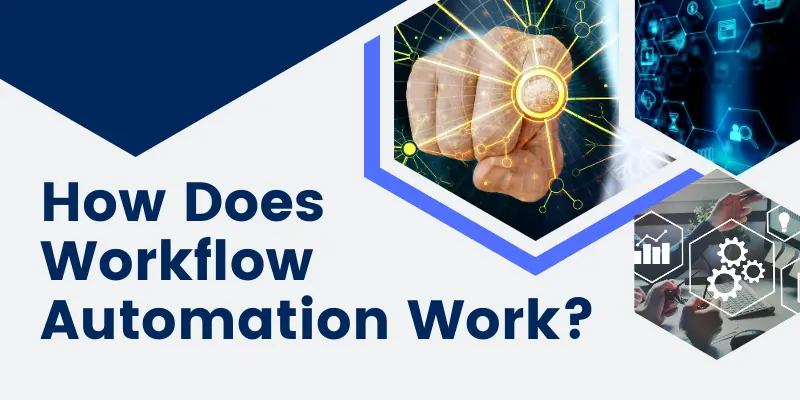The Power of Workflow Automation Software- Transform Your Business Efficiency Today
Published: 19 Mar 2025
In today’s fast-paced business environment, efficiency is crucial. Workflow Automation Software has become a game-changer for businesses aiming to streamline operations, reduce costs, and enhance productivity. But what exactly is workflow automation, and how can it benefit your business? Let’s explore.
What Is Workflow Automation Software?
Workflow automation software is a tool designed to automate repetitive, manual tasks by creating predefined workflows. These workflows consist of a series of steps that, once set up, run automatically without human intervention. Think of it as a digital assistant that handles routine tasks, allowing your team to focus on strategic initiatives.
How Does Workflow Automation Work?

Workflow automation software connects various systems, apps, and processes. For example:
- Automatically sending follow-up emails after a customer submits a form.
- Updating your CRM when a sale is completed.
- Notifying your team when a task deadline approaches.
It’s like setting up a domino effect—the rest follow seamlessly once the first step is triggered.
Key Benefits of Workflow Automation Software
Workflow automation software offers numerous advantages for businesses of all sizes. Here are the top benefits:
1. Saves Time and Boosts Productivity
Automating repetitive tasks allows employees to focus on high-value activities, leading to increased productivity.
2. Reduces Human Errors
Automation minimizes the risk of mistakes caused by manual data entry or oversight.
3. Cuts Operational Costs
Automating workflows reduces the need for manual labor, saving both time and money.
4. Enhances Team Collaboration
Automated workflows ensure everyone is on the same page, improving communication and collaboration.
5. Improves Customer Experience
Faster response times and personalized interactions lead to happier customers.
Common Industries That Use Workflow Automation

Workflow automation is versatile and used across various industries, including:
Healthcare
Automating patient appointment scheduling and billing.
Finance
Streamlining invoicing and expense approvals.
Retail
Managing inventory and order processing.
Marketing
Automating email campaigns and social media posts.
HR
Simplifying employee onboarding and leave requests.
How Does Workflow Automation Work? A Step-by-Step Breakdown
Let’s take an example of automating email responses:
- A customer submits a query through your website.
- The workflow automation tool detects the submission.
- It triggers an automated email acknowledging the query.
- Simultaneously, it notifies your support team to follow up.
Common Workflows That Can Be Automated
Marketing
- Lead nurturing
- Social media scheduling
HR
- Employee onboarding
- Payroll processing
Finance
- Invoice generation
- Expense approvals
Features to Look for in a Good Workflow Automation Tool
When choosing workflow automation software, consider these essential features:
1. Drag-and-Drop Workflow Builder
An easy-to-use interface for creating workflows.
2. Integration with Popular Apps
Compatibility with tools like Slack, Trello, and CRM systems.
3. Customization Options
Flexibility to tailor workflows to your needs.
4. Reporting and Analytics
Insights into workflow performance.
5. Security and Compliance
Data protection and adherence to industry standards.
Best Workflow Automation Software in 2025

Here are some of the top tools to consider:
1. Zapier
Connects thousands of apps for seamless automation.
2. Monday.com
Visual workflow management with collaboration features.
3. HubSpot
Ideal for marketing and sales automation.
4. Make (formerly Integromat)
Advanced automation with visual workflows.
5. Automate.io
Affordable and user-friendly for small businesses.
How to Choose the Right Workflow Automation Software
1. Identify Business Needs
Determine which tasks need automation.
2. Check Ease of Use
Ensure the tool is user-friendly.
3. Consider Scalability
Choose software that grows with your business.
4. Compare Pricing and Features
Find the best value for your budget.
5. Look for Customer Support
Reliable support is crucial for troubleshooting.
Common Mistakes to Avoid When Using Workflow Automation
1. Automating the Wrong Tasks
Focus on repetitive, time-consuming tasks.
2. Ignoring User Training
Ensure your team knows how to use the software.
3. Not Monitoring Performance
Regularly review workflows to optimize them.
4. Overcomplicating Workflows
Keep workflows simple and effective.
Real-Life Examples of Workflow Automation in Action
Small Business Automating Invoicing
A bakery uses automation to send invoices to customers as soon as orders are placed.
Marketing Team Automating Social Media Posts
A marketing agency schedules posts across multiple platforms using automation.
HR Automating Employee Onboarding
A tech company uses automation to send welcome emails, assign tasks, and set up accounts for new hires.
Conclusion
Workflow automation software is a powerful tool that can transform the way your business operates. From saving time and reducing errors to improving customer experience, the benefits are undeniable. Whether you’re a small business or a large enterprise, there’s an automation solution for you.
Ready to get started? Explore free trials of tools like Zapier or Monday.com and see how automation can revolutionize your workflows today!
FAQs About Workflow Automation Software
No, businesses of all sizes can benefit from automation.
No, most tools are no-code or low-code, making them accessible to non-technical users.
No, automation complements human work by handling repetitive tasks, not replacing creativity or decision-making.
Zapier and Automate.io offer robust free plans for small businesses.
It’s a tool that automates repetitive tasks like sending emails or updating spreadsheets.
Check if the automation is properly set up with the correct triggers and actions. Ensure connected apps have the necessary permissions.
This may happen if a condition in the workflow is not met. Double-check the rules, filters, and triggers.
Adjust the settings to add a delay or prevent duplicate runs. Many tools offer filters to control execution.
Use conditional logic to create “if this, then that” rules.
Trigger-based automation starts when an event happens (e.g., a new email arrives). Schedule-based automation runs at set intervals (e.g., every Monday at 9 AM).

- Be Respectful
- Stay Relevant
- Stay Positive
- True Feedback
- Encourage Discussion
- Avoid Spamming
- No Fake News
- Don't Copy-Paste
- No Personal Attacks

- Be Respectful
- Stay Relevant
- Stay Positive
- True Feedback
- Encourage Discussion
- Avoid Spamming
- No Fake News
- Don't Copy-Paste
- No Personal Attacks




